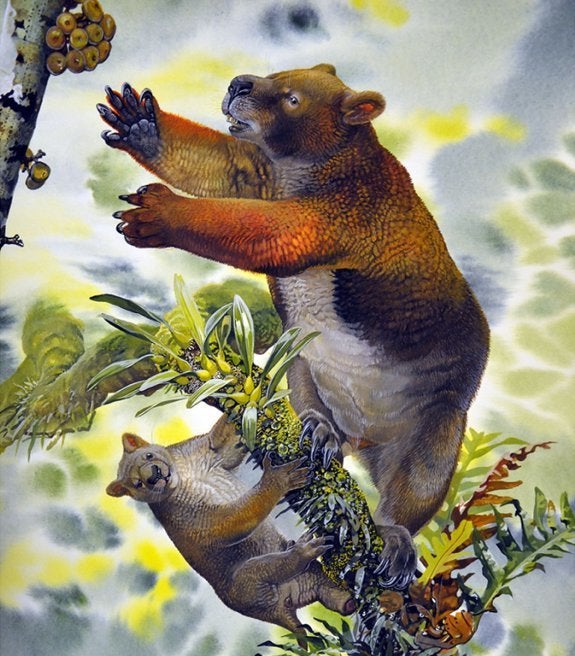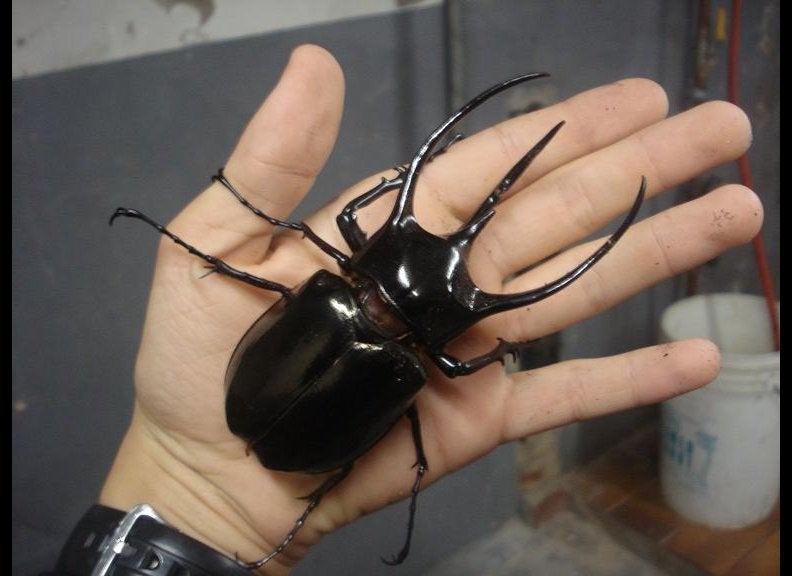By: Megan Gannon, News Editor
Published: 11/27/2012 08:20 AM EST on LiveScience
Some 15 million years ago, mobs of 150-pound (70-kilogram) marsupials roamed the treetops of Australia's rain forests, researchers say.
Nimbadon lavarackorum belonged to a family of large-bodied marsupials known as the diprotodontids that went extinct about 11,000 years ago. During the diprotodontids' reign in Australia, they ranged from sheep-size wombatlike creatures to the mega-herbivore Diprotodon, which stood at 13 feet (4 meters) tall and weighed up to 6,100 pounds (2,800 kg).
Nimbadons were on the small-end of this spectrum, and they lived during the Middle Miocene (about 16 million to 11.6 million years ago). These ancient marsupials are best known from 26 different specimens found at the bottom of a vertical cave in northwestern Queensland, where a group of them apparently plunged to their deaths. In a new study, researchers examined Nimbadon bones and compared them with other species to get a clearer picture of how these ancient animals might have lived.
The researchers said they found striking similarities between Nimbadon skeletons and those of current koalas, including strong forelimbs, large claws and highly mobile shoulder and elbow joints. These features, combined with the Nimbadon's short hind limbs, suggest that the animals had excellent climbing and grasping skills and also could have used their long, flexible arms to suspend themselves from branches and reach for food and supports.

Composite Nimbadon lavarackorum skeleton from AL90, Riversleigh.
Even though the diprotodontids were thought to have lived on the ground, all these characteristics point to a life in the trees, which would make Nimbadons the largest herbivorous mammals to have ever lived in the forest canopies of Australia — an ecological niche that is now empty, the researchers say.
"The findings presented here indicate that we are only beginning to understand the range of morphological and niche diversity displayed by this ecologically important and widespread group of Australasian marsupials — the diprotodontids," the researchers concluded.
The study, led by a team from the University of New South Wales in Sydney, was published online Nov. 21 the journal PLoS ONE.
Follow LiveScience on Twitter @livescience. We're also on Facebook & Google+.
Copyright 2012 LiveScience, a TechMediaNetwork company. All rights reserved. This material may not be published, broadcast, rewritten or redistributed.
Support HuffPost
Our 2024 Coverage Needs You
Your Loyalty Means The World To Us
At HuffPost, we believe that everyone needs high-quality journalism, but we understand that not everyone can afford to pay for expensive news subscriptions. That is why we are committed to providing deeply reported, carefully fact-checked news that is freely accessible to everyone.
Whether you come to HuffPost for updates on the 2024 presidential race, hard-hitting investigations into critical issues facing our country today, or trending stories that make you laugh, we appreciate you. The truth is, news costs money to produce, and we are proud that we have never put our stories behind an expensive paywall.
Would you join us to help keep our stories free for all? Your contribution of as little as $2 will go a long way.
Can't afford to donate? Support HuffPost by creating a free account and log in while you read.
As Americans head to the polls in 2024, the very future of our country is at stake. At HuffPost, we believe that a free press is critical to creating well-informed voters. That's why our journalism is free for everyone, even though other newsrooms retreat behind expensive paywalls.
Our journalists will continue to cover the twists and turns during this historic presidential election. With your help, we'll bring you hard-hitting investigations, well-researched analysis and timely takes you can't find elsewhere. Reporting in this current political climate is a responsibility we do not take lightly, and we thank you for your support.
Contribute as little as $2 to keep our news free for all.
Can't afford to donate? Support HuffPost by creating a free account and log in while you read.
Dear HuffPost Reader
Thank you for your past contribution to HuffPost. We are sincerely grateful for readers like you who help us ensure that we can keep our journalism free for everyone.
The stakes are high this year, and our 2024 coverage could use continued support. Would you consider becoming a regular HuffPost contributor?
Dear HuffPost Reader
Thank you for your past contribution to HuffPost. We are sincerely grateful for readers like you who help us ensure that we can keep our journalism free for everyone.
The stakes are high this year, and our 2024 coverage could use continued support. If circumstances have changed since you last contributed, we hope you’ll consider contributing to HuffPost once more.
Already contributed? Log in to hide these messages.


